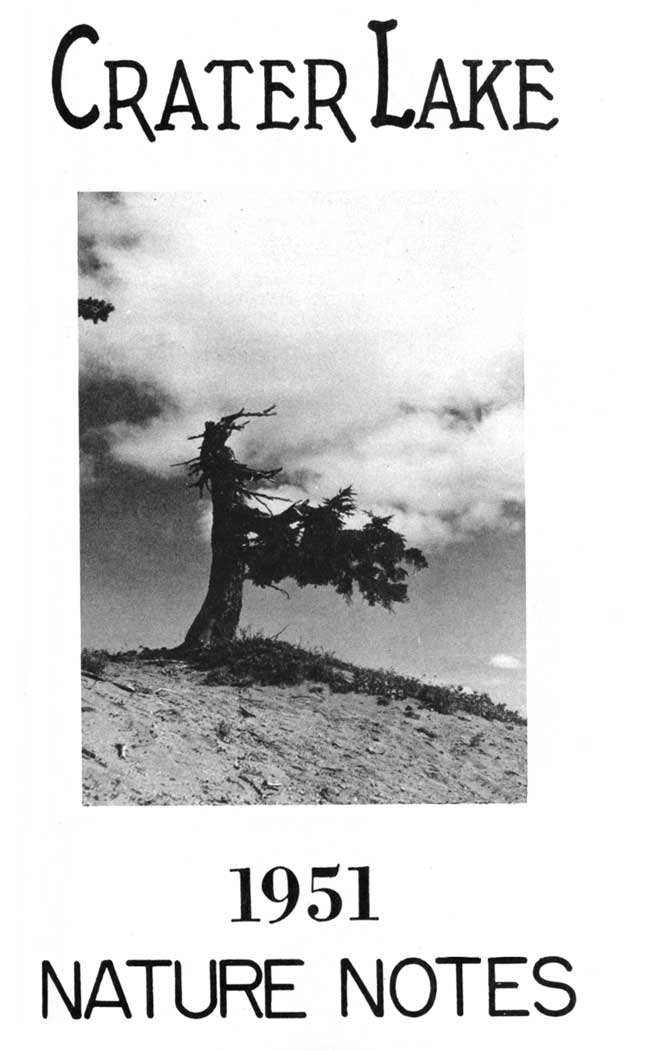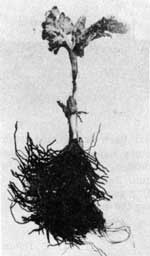Volume 17, 1951
All material courtesy of the National Park Service.These publications can also be found at http://npshistory.com/
Nature Notes is produced by the National Park Service. © 1951
My Search for Botrychium Pumicola
In the acute appreciation of the value and contribution of science towards modern life, the Westinghouse Electric Corporation and Science Service of Washington, D.C., have combined forces to ferret out talent of promise among graduating seniors in high schools all over the United States. This is known as the Science Talent Search that has been heralded in magazines and press. Basic requirements are: (1) a superior and versatile high school record, (2) a science aptitude test, and (3) study and performance of a significant scientific project. The reward is a scholarship in a science major in an American university of the contestant’s choice.
I had been extremely interested in entering this competition. Several projects passed through my mind before I took a job to help the ranger naturalists in the park. Immediately I was thrilled by the ideals of the National Parks and the varied, exciting possibilities for a project at Crater Lake. There is intense fascination in how plants came to the mountain after the climax eruption, how they have adapted themselves to the vicissitudes of the forbidding area, how they have succeeded in the various patterns that exist today. Then came the story of Botrychium pumicola told by one of the naturalists.
Here on the bleak summits of Llao Rock and Cloudcap, both buried in pumice scores of feet deep, are plant colonies and associations that have learned to get along in the intense sunlight, desiccating winds, cold nights, and bitter exposure, plants that because of their peculiar situation have acquired characteristics more closely akin to those desert types than to those of Alpine-Arctic members in similar high places. Here is found that delicate relative of the ferns with a tremendous root system and a single depauperate leaf that scarcely extends two inches above the soil: one of the rare plants of the world whose natural growing area may not even be the total of one acre.
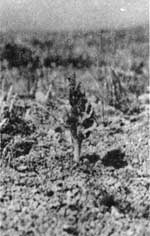 “…scarcely to be discerned against the drab background: Botrychium itself!” Approximately half life-size. |
Botrychium pumicola was discovered on the high open slope of Llao Rock by Dr. Frederick V. Coville, Chief Botanist of the U.S. Department of Agriculture in August, 1896. He discovered a second small colony on Cloudcap in 1902. Both of these localities are about 8000 feet in elevation. These two tiny plant islands were the only places in which the plant was known to grow until Dr. L. R. Detling of the University of Oregon collected it in 1928 on a summit just east of Paulina Peak near Newberry Crater. This is sixty miles northeast of Crater Lake from which it is separated by a pumice-covered surface of a lower and relatively flat elevation.
In this 1951 season that was early for plant activities, it was almost August before my plans for a project fully materialized. My initial search for the obscure plant was met with frustration. It proved to be annoyingly evasive. I had expected to find it sparse, but did not think that I should have to have my nose rubbed into it to discover what it looks like in the field. My initial trips to its home resulted in failure, but I would not give up. At last, when I began to doubt its existence it yielded: there it was in an exclusive and minute colony, perhaps fifty by twenty feet and resembling a crescent in shape. Its color of glaucous-green in its prime blends well with surroundings, and in the late season it had added a yellowish tinge that further diminishes its visibility. The slope on which it grows is gentle and close to the inside of the break that follows the crest of the prominence. The colony is 300 feet west of the benchmark on the summit that bears the legend, elevation 8046 feet. I noted in particular its associates which are few in number of species. Chiefly there are silver flower (Raillardella argentea), that odoriferous buckwheat well remembered by its name, dirty socks, (Eriogonum pyrolaefolium coryphaeum), and the interesting broom-rape (Orobanche fasciculata franciscana) that is parasitic on the buckwheats and polygonums.
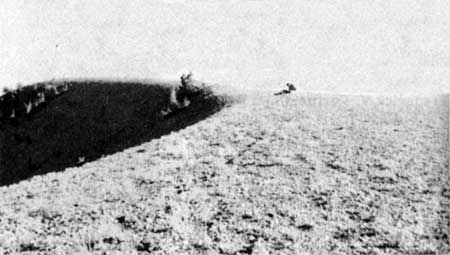
“…a likely looking crescentic ridge…”
It was now my fascination to make the trip to Newberry Crater to see if I could retrace Detling’s discovery. On September 7, I had my opportunity. On hands and knees, I scoured a likely-looking crescentic ridge southeast of East Lake. The dried remains of my friend Orobanche proved to be the decisive lead. Sure enough, there it was, its small and somewhat dried form scarcely to be discerned against the drab background: Botrychium itself! The lineal spread of the colony seemed great to me, being over 350 feet. In contrast, the greatest width appeared to be no more than five feet. The precise location of this colony is in T. 22 S., R. 13 E., Sec. 4. I ascended the ridge on a course due east from the car that was parked alongside a Forest Service section line marker that indicates that it is placed 350 feet south of the midpoint of the line between sections 4 and 5. To the south and practically on the level with the car is a pass over which the road winds and which is given an elevation of 7176 feet on the map. I estimated our colony to be 300 to 500 feet higher. Later I learned that Dr. Detling’s collection was made on a summit west of the road.
From my high place, the summits of the Cascades looked so near and alluring. Could it be that Botrychium might find a home there, too? Little chance of such occurrence, but nevertheless, there I wandered two days later. The first locality of promise was the rounded top of Tumalo Mountain on which perches a Forest Service fire-lookout at its apex, 7772 feet. The soil, though the familiar fine pumice with a cover of coarse pumice- mulch, looked somewhat different, having a reddish hue caused by an admixture of ash of that color. The familiar indicators were there, but the most numerous member of the colony was Anemone globosa, that was absent in the other three localities in which I discovered Botrychium. Here, as elsewhere, Raillardella was the most encouraging lead. I scrutinized the whole summit area on my hands and knees, hoping against hope that the small treasure might be my reward. The entire dismal start of my search for the fern passed through my mind’s eye. It was so improbable, and the efforts seemed so futile. But no! There it was: a single specimen growing scarcely an inch above the ground 80 feet due north of the lookout whose location is in T. 18 S., R. 9 E., Sec. 10. But despite piercing search and dogged persistence, only one other plant could be found, scarcely twenty feet away from the first specimen.
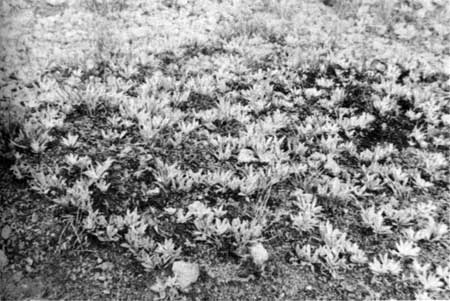
“…patch of Raillardella examined with tireless care.”
In that afternoon of September 9, I made a sortie up a likely-looking ridge leading northeast from Broken Top. Higher and higher led the search, later and later grew the hour. Each patch of Raillardella was examined with tireless care. Already the highest elevation had been passed at which the plant had been found elsewhere. Prospects and light were growing dimmer, and an autumn chill gripped the darkening landscape. It was imperative that I start down the grim crags. Then in the gloom of faded light and hope, a single stem shimmered out of the bare soil, attended by a complete circle ofRaillardella, a few feet in diameter. It was the capping triumph of my great day! The exact locality of my find is T. 17 S., R. 9 E., Sec. 20, at an elevation of over 8500 feet!
The collected specimens were pressed and prepared for mounting. I sent the Cascade prizes and examples from the other three localities for study and positive identification to Dr. Robert Clausen of Cornell University, the celebrated expert onOPHIOGLOSSACEAE to which Botrychium belongs. I donated other specimens to the herbarium of the University of Oregon which is under the direction of Dr. L. R. Detling. A report of their conclusions should follow in a future number of NATURE NOTES.


